547824
Tris[N,N-Bis(trimethylsilyl)amide]gadolinium(III)
98%
Sinónimos:
Gadolinium bis(trimethylsilyl)amide, Gadolinium tris[bis(trimethylsilyl)amide]
About This Item
Productos recomendados
assay
98%
form
solid
reaction suitability
core: gadolinium
reagent type: catalyst
mp
67-90 °C (lit.)
SMILES string
C[Si](C)(C)N([Gd](N([Si](C)(C)C)[Si](C)(C)C)N([Si](C)(C)C)[Si](C)(C)C)[Si](C)(C)C
InChI
1S/3C6H18NSi2.Gd/c3*1-8(2,3)7-9(4,5)6;/h3*1-6H3;/q3*-1;+3
InChI key
LFWPRLGQJJEPDP-UHFFFAOYSA-N
General description
Application
signalword
Danger
hcodes
Hazard Classifications
Flam. Sol. 1 - Skin Corr. 1B - Water-react 2
supp_hazards
Storage Class
4.3 - Hazardous materials which set free flammable gases upon contact with water
wgk_germany
WGK 3
flash_point_f
36.0 °F - closed cup
flash_point_c
2.2 °C - closed cup
ppe
Eyeshields, Faceshields, Gloves, type P3 (EN 143) respirator cartridges
Certificados de análisis (COA)
Busque Certificados de análisis (COA) introduciendo el número de lote del producto. Los números de lote se encuentran en la etiqueta del producto después de las palabras «Lot» o «Batch»
¿Ya tiene este producto?
Encuentre la documentación para los productos que ha comprado recientemente en la Biblioteca de documentos.
Nuestro equipo de científicos tiene experiencia en todas las áreas de investigación: Ciencias de la vida, Ciencia de los materiales, Síntesis química, Cromatografía, Analítica y muchas otras.
Póngase en contacto con el Servicio técnico![Tris[N,N-bis(trimethylsilyl)amide]yttrium](/deepweb/assets/sigmaaldrich/product/structures/867/983/5b7cb7cd-8879-49e4-a9d7-29c52aaa82a0/640/5b7cb7cd-8879-49e4-a9d7-29c52aaa82a0.png)
![Tris[N,N-bis(trimethylsilyl)amide]samarium(III) 98%](/deepweb/assets/sigmaaldrich/product/structures/285/605/c4a36589-b92a-45c3-83a9-806ca49f392d/640/c4a36589-b92a-45c3-83a9-806ca49f392d.png)









